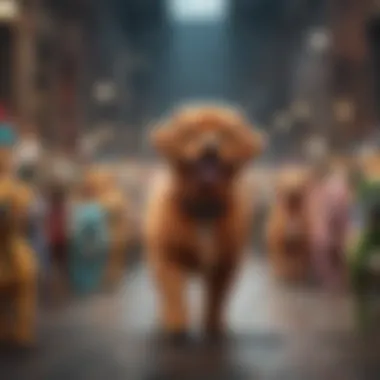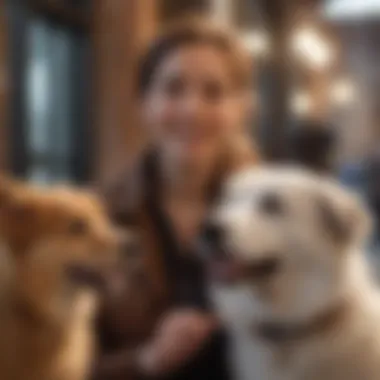The Dynamics of a Pet Parade: Participation and Protocol


Intro
Pet parades serve as vibrant hubs for animal lovers, where various breeds showcase their charm in a lively atmosphere. These events are not merely spectacles but also reflect the cultural nuances and deep attachments we form with our pets. Understanding the nuances of participation and the protocols involved enhances the experience for both pets and their owners. This section will provide insights into essential preparation techniques that pet owners should consider before attending a pet parade.
Pet Care and Grooming
Importance of Regular Care
In preparation for a pet parade, owners should prioritize regular care routines. Pets, like humans, thrive on consistency in hygiene and grooming, which not only makes them look their best but also contributes to their overall well-being. Proper grooming keeps pets comfortable and helps prevent behavioral issues that may arise from neglect, particularly in high-stress situations like parades.
Grooming Techniques by Pet Type
Each type of pet has distinct grooming requirements. For example:
- Dogs: Regular brushing helps reduce shedding and mats. Breeds with long hair may need daily combing.
- Cats: Regular brushing is crucial for long-haired cats to avoid tangles.
- Rabbits: Grooming helps manage their fur and decreases the risk of fur ingestion.
Understanding these methods can lead to more comfortable and well-behaved pets during events.
Tools and Products Recommendations
Selecting the appropriate grooming tools is essential. Here are a few recommended items:
- For Dogs: Slicker brushes, de-shedding tools, and nail clippers are crucial for maintaining a dog's coat and overall hygiene.
- For Cats: A de-shedding comb and a nail trimmer can help prepare cats for public outings.
- For Rabbits: A soft brush and nail clippers will ensure they are carnival-ready.
Seasonal Care Tips
Seasonal changes can significantly affect grooming needs. During warmer months, pets may require more frequent baths and haircuts to stay cool. In winter, it’s important to monitor paw health, considering ice and salt can irritate skin. Providing appropriate care ensures that pets remain comfortable and healthy throughout the parade.
Health and Nutrition
Understanding Pet Nutrition
One must consider dietary health when preparing for a pet parade. Ensuring that pets are properly nourished leads to more robust energy levels. A balanced diet includes necessary vitamins, minerals, and proteins tailored to the pet’s specific needs.
Common Health Issues by Species
Different pets have unique health considerations:
- Dogs: Conditions like hip dysplasia or obesity can affect their performance and comportment.
- Cats: Dental health is a frequent issue which can impact overall wellness.
- Rabbits: Digestive issues are common if their diet lacks fiber.
Owners should be aware of these issues to adequately prepare and respond to any health-related urgencies during events.
Preventive Care and Regular Check-Ups
Regular veterinary check-ups can dramatically enhance a pet's health and readiness for events. Ensuring vaccinations are up-to-date and discussing any concerns well in advance are key steps.
Food and Dietary Advice
Feeding pets a diet rich in essential nutrients in the days leading up to a parade can enhance their stamina and demeanor. It is advisable to consult a veterinarian or a pet nutrition expert for tailored advice.
Behavioral Training
Basics of Positive Reinforcement
Training pets with positive reinforcement techniques cultivates desirable behaviors. This approach encourages good conduct during crowded, loud settings like parades. Positive rewards can reinforce good behavior, thereby minimizing anxiety or stress.
Training Techniques Users Can Apply
Techniques such as teaching commands with treats can be beneficial for both dogs and cats. Utilizing short training sessions to teach specific behaviors related to the parade environment can significantly aid in performance.
Managing Behavioral Issues
Identifying and managing potential behavioral problems is critical. Owners should learn to recognize signs of stress or anxiety in their pets to implement immediate solutions.
Importance of Socialization
Prior to the parade, socializing pets with different environments and animals can enhance their comfort levels. Frequent exposure reduces anxiety and fosters confidence, improving the overall experience.
Engaging Activities and Enrichment


Fun Games to Play with Your Pet
Interactive games such as fetch or hide and seek can stimulate mental agility and strengthen the bond between pets and owners. Preparing pets for the hustle of a parade can be facilitated by incorporating varied playful activities.
DIY Toys and Activities
Creating simple DIY toys, like a tug toy made from old clothes, can provide enrichment without significant expense. Engaging activities enhance pets' focus and energy levels.
Importance of Mental Stimulation
Providing pets with mental stimulation through puzzles or scent work is crucial for reducing pre-parade jitters. It effectively uses their energy constructively, hence lowering stress levels.
Outdoor Adventures and Exploration
Prior to the parade, exploring local parks or trails helps acclimatize pets to public spaces, which can build confidence and lessen anxiety on the event day.
Resources and Community Engagement
Recommended Books and Websites
For further reading, owners can explore resources such as Wikipedia's articles on pet care and pertinent Britannica entries that address species-specific needs. Online materials can enhance understanding of effective preparation.
Forums and Groups for Pet Owners
Engaging with communities on platforms such as Reddit or Facebook offers opportunities for advice and shared experiences. This networking can provide insights into best practices directly from fellow pet owners.
Finding Local Services and Classes
Utilizing available local resources for training and grooming services can be beneficial. Various community centers often list programs tailored to pet owners, making it easier to prepare.
Encouraging Community Sharing and Contributions
Building a community around pet ownership encourages sharing valuable information, leading to enriched experiences for everyone involved in future parades and events.
Pet parades blend fun with important lessons in care, health, and community. Engaging positively with pets enhances the overall experience while fostering connections among pet lovers.
Preface to Pet Parades
Pet parades serve as a vibrant expression of the bond between humans and their pets. They bring together diverse groups of pet owners and animal lovers, showcasing the affectionate relationships cultivated through mutual care and companionship. Understanding pet parades is crucial for both novice and experienced pet owners alike. Learning about the structure and protocols of these events enhances not only the experience for the participant but also for the audience.
The Origin of Pet Parades
Pet parades have a rich history that dates back to the early 20th century. They initially began as small gatherings that celebrated pets and their owners. Over time, pet parades evolved into larger events, often tied to local festivals or community celebrations. The motivation behind these parades has always been to foster bonds within the community while honoring the joy that pets bring to our lives. It is fascinating to note how these events have persisted through the decades, adapting to societal changes and the evolving relationship we hold with pets.
Cultural Significance of Pet Parades
Culturally, pet parades act as a social platform, blending entertainment, love for animals, and community engagement. They often reflect regional traditions, highlighting different types of pets and ways of celebration. In urban settings, pet parades can promote responsible pet ownership and educate the public about animal welfare. They also provide an opportunity for local businesses and organizations to come together and support the pet-loving community. Thus, they hold substantial significance in promoting community cohesion and celebrating diversity within the pet culture.
Overview of Common Events
Common events during pet parades include costume contests, agility displays, and interactive booths for pet health and care. These activities not only entertain but also offer educational opportunities for pet owners. The atmosphere is typically lively, filled with music, laughter, and the joy of celebrating beloved pets. Here are some events commonly seen at pet parades:
- Costume Contests: Pets dressed in creative outfits showcase their personalities.
- Agility Competitions: Pets demonstrate their training and skills.
- Community Booths: Local stores and animal welfare organizations provide information and resources.
- Photo Opportunities: Spaces are usually set up for memorable pictures.
Engagements like these facilitate connections among pet owners and enrich the community experience, creating lasting memories.
Pet parades not only celebrate pets but also foster a sense of community among diverse groups of people.
Understanding the 'Stay Off Mat' Concept
The phrase 'Stay Off Mat' serves as a fundamental guideline within the structure of pet parades. It reflects the need for organization and orderliness essential to both human and pet participants. By instilling boundaries through this phrase, organizers aim to ensure that events progress smoothly while reducing potential stressors for both pets and owners. The concept not only facilitates the flow of activities but also underscores the importance of respect for personal spaces in a crowded environment.
What Does 'Stay Off Mat' Mean?
The expression 'Stay Off Mat' pertains to designated areas within the parade venue where specific rules govern behavior. It usually indicates that participants should refrain from accessing certain mats or zones, often where judging or evaluations take place. Such spots are typically reserved for special activities or are meant to minimize distractions for pets who may feel overwhelmed by the surrounding crowd. Ultimately, this directive promotes a predictable setting for all involved, which is crucial for the comfort of both pets and their owners.
Importance of Boundaries
Boundaries serve an essential role during pet parades by clearly delineating areas of activity. They contribute to a sense of security for pets. The presence of these boundaries can prevent unnecessary interruptions that might lead to anxiety or aggression. Maintaining these limitations also fosters a conducive environment for social interaction amongst participants, allowing pets and owners to engage more comfortably. Moreover, when attendees adhere to these guidelines, it enhances the overall atmosphere, making the event enjoyable for everyone.


In essence, boundaries serve as guidelines for good behavior and civility. By respecting these limits, pet owners can model appropriate behaviors for their pets, which in turn reinforces their training.
Addressing Safety Concerns
Safety remains a critical consideration at pet parades. The 'Stay Off Mat' concept directly relates to mitigating risks associated with large crowds and unpredictable pet behavior. Crowds can provoke anxiety in pets, leading to reactive behavior that poses risks to both the owner and surrounding attendees. By guiding participants to areas where they are less likely to feel threatened or cornered, the protocol helps alleviate some of these concerns.
It is also important to acknowledge the various sizes of pets and their potential interactions with one another. Smaller animals, for instance, may feel intimidated by larger breeds. Similarly, not all pets have the same socialization level, which could lead to unpredictable encounters. Therefore, the directive to stay within specified boundaries is an essential component of ensuring everyone's well-being.
In summary, the 'Stay Off Mat' concept fosters a structured environment that prioritizes the safety and comfort of pets and owners alike. This understanding is invaluable for pet owners planning to participate in parades, allowing them to navigate the event with ease.
Planning for Participation
Understanding how to effectively plan for participation in pet parades is crucial for ensuring a successful experience for both pets and their owners. Various factors need to be considered ahead of time to maximize enjoyment and minimize stress, making it a key focus of this article.
Choosing the Right Event
Selecting an appropriate event can greatly influence the overall experience. Various pet parades cater to different types of pets and specific community themes. Attend local events that align with your pet's personality and comfort level. Some events might embrace costume displays, while others may focus on showcasing trained pets.
Research nearby pet parades in advance by checking local community boards or social media platforms like Facebook. It is also helpful to read past attendee reviews, which can provide insights into organization quality and atmosphere. A well-suited event enhancess the likelihood of a positive outing.
Preparing Your Pet for the Parade
Preparation involves not just physical readiness, but also mental preparation for both owner and pet. Start by ensuring that your pet is comfortable in a crowd. Introduce them to different environments and take short trips to smaller gatherings with similar settings. This can minimize anxiety on the day of the parade.
Also, grooming your pet is essential. A fresh look can boost confidence and enhance the overall experience. Make sure your pet wears proper identification, a leash, and any other necessary gear for safety. Have treats on hand to reward your pet during the event.
Logistics and Timing
Logistical planning is vital for a smooth participation process. Create a timeline that includes when to leave your home, travel time, and any specific pre-parade requirements. Arriving early is a strategic move, as it allows for acclimatization to the venue and an opportunity to meet other pets and owners.
Consider factors such as parking, accessibility, and available facilities like rest areas. Having a clear understanding of these logistical components aids in minimizing stress on the event day. Utilize mobile applications for navigation and monitor local traffic updates to avoid delays.
In summary, effective planning for participation in a pet parade involves the careful selection of the event, preparation of your pet, and attention to logistical details. Establishing these foundational practices ensures a more enjoyable experience. An organized approach is key to engaging positively with the community, while also keeping your pet's well-being as a top priority.
Behavioral Expectations and Training
Understanding behavioral expectations and training is vital for a successful pet parade experience. These events place animals and humans in close proximity, which increases the need for control and good behavior from pets. A well-trained pet contributes to a smoother event, minimizing stress for both the pet owner and other attendees. The importance of training cannot be overstated, as it ensures safety and enjoyment for everyone involved.
Training Your Pet for Public Events
Training your pet for public events requires planning and reflection. It involves teaching your pet to behave appropriately in environments with many distractions, such as loud noises, unfamiliar people, and other animals. Basic obedience commands like sit, stay, and come can be reinforced through rehearsals in controlled settings. This lays the groundwork for success during the parade.
Consider enrolling your pet in a specific training class designed for public events. Professional trainers can provide guidance on techniques tailored for noisy, bustling environments. Consistent practice helps your pet understand what is expected of them. Working with positive reinforcement methods can motivate your pet to perform well. A well-prepared pet behaves calmly and confidently.
Managing Aggression and Anxiety
Managing aggression and anxiety is crucial for both pet and owner during a parade. Some pets may react negatively to the energy of the crowd or other animals. Early identification of triggers is necessary. If your pet shows signs of fear, it’s essential to address these behaviors ahead of time. Working with a behaviorist can help in creating a plan tailored to your pet's needs.
It’s important to expose your pet to various situations gradually. Introduce them to bustling spaces where many people gather. Positive experiences reduce anxiety over time. If your pet has a history of aggression, keep them in familiar scenarios with controlled exposure. Ensuring your pet's stress levels are managed allows for better focus and behavior during the event.
Socialization Prior to the Event
Socialization plays a significant role in preparing your pet for a parade. A well-socialized pet is likely to handle shared spaces with more ease. Arrange playdates with other pets or visit dog parks leading up to the event. Familiarity with different animals and people will help your pet acclimate.
Ensure that socialization opportunities are positive and stress-free. Observe how your pet interacts with others and be ready to intervene if necessary. Gradually increase exposure to different scenarios and environments, including those that mirror the event setting. Remember, the goal is to create positive associations, establishing comfort in diverse scenarios that can arise during the parade.
Ultimately, the right training and socialization strategies ensure that pet parades remain enjoyable experiences for all, enhancing the bond between pets and their owners.
Navigating the Event Day
Navigating the event day is an essential aspect of the pet parade experience. The overall success of the day relies heavily on preparation and awareness of various elements at play. This not only affects pet owners but also the pets themselves. Being organized and informed ensures that both animals and humans have a good time. This section will discuss important factors from arriving at the venue to handling unexpected situations that may arise.
Arriving at the Venue
When you arrive at the venue, timing is crucial. It's best to get there early to familiarize yourself with the environment. Allowing extra time prevents the stress of rushing. Arriving on time also helps to secure a good spot for your pet and allows you to find your way around. It is often busy, with many people and animals present. Pay attention to signage that indicates designated areas for different activities.
Additionally, ensure that your pet is ready for the surroundings. Maintaining a calm demeanor can greatly influence your pet's behavior in a new environment. An early arrival allows for some exploration so that your pet can adjust.
Following Event Protocol


Following event protocol is critical for ensuring safety and camaraderie among participants. Each event may have its own set of rules. Understanding these will help you navigate the parade smoothly. For instance, be aware of the specified paths and areas where pets are allowed. This is usually outlined in event materials or during pre-event briefings.
Additionally, your pet should be on a leash at all times, unless indicated otherwise. Respecting the personal space of other participants is also essential. A well-behaved pet contributes to a friendly atmosphere, enhancing the experience for all involved.
Following the rules not only ensures safety but also reflects positively on you as a responsible pet owner.
How to Handle Unexpected Situations
Even the most well-planned events can encounter unexpected situations. Being ready for the unpredictable can make a significant difference. First, know where the event organizers will be located. They can assist in emergencies, whether it is a lost pet or a more serious issue.
Be alert and observant. If your pet shows signs of stress or aggression, calmly remove them from the situation. This can reduce the chances of escalation. Having a go-to plan, such as a quiet area for your pet to regroup, can work wonders.
Realizing that not everything goes as planned is part of the experience. Embracing flexibility and staying calm will benefit you, your pet, and the atmosphere of the event.
Navigating the event day efficiently sets the path for a more enjoyable pet parade. Understanding these elements allows for better engagement with both your pet and the community.
Engaging with the Community
Engaging with the community is a pivotal aspect of pet parades. These events present an opportunity for pet owners to connect not only with their pets but also with fellow enthusiasts, fostering a rich tapestry of shared experiences. The dynamics of communal interactions during these parades are complex yet rewarding, offering myriad benefits that can enhance the overall experience for all participants.
Building Connections with Other Pet Owners
One of the primary goals during pet parades is building connections with other pet owners. Each participant brings unique stories, which can serve as a foundation for networking. Such encounters can lead to partnerships in pet care, advice sharing, or even the formation of local pet clubs.
A few key observations include:
- Shared Interests: Owners share a mutual love for pets, often making conversations flow easier.
- Expertise Exchange: More experienced pet owners can provide valuable tips and insights.
- Socializing Opportunities: Pets can interact as well. This mutual interaction can lead to friendships among pets, which can be beneficial for future socialization.
Sharing Experiences and Insights
The act of sharing experiences with others can significantly enrich the pet parade experience. Owners often recount tales of training, behavioral quirks, or overcoming challenges, enhancing the communal atmosphere. These narratives can facilitate a better understanding of different pet types and care practices.
Consider the following points when sharing:
- Inclusivity: Every story is valuable. Sharing successes and struggles promotes an inclusive environment.
- Learning: New pet owners can gain knowledge from the experiences of seasoned pet lovers.
- Feedback: Engaging discussions can offer constructive feedback on various pet care approaches.
Fostering a Sense of Community
A sense of community emerges naturally in pet parades. This camaraderie is often rooted in shared joys and mutual challenges. By participating, owners contribute to a larger conversation about pet welfare and shared responsibilities.
Key factors that contribute to this sense of community include:
- Support Networks: These events can act as a platform for forming support networks among owners, enhancing pet care strategies.
- Collective Celebrations: Celebrating the unique traits of various pets can instigate pride among owners, enhancing community bonds.
- Collaborative Events: Organizing joint activities, such as charity drives or group training sessions, can further grow relationships among pet owners.
Engaging with fellow pet owners at parades fosters friendship and creates support networks that can last far beyond the event itself.
Post-Event Reflections
Reflecting after a pet parade is a significant practice for both participants and organizers. This phase is often overlooked, yet it holds immense value in assessing the event's success and identifying areas for improvement. Engaging in post-event reflections enhances the understanding of what worked well and what can be refined in future events.
Evaluating the Experience
Evaluating the experience begins with a personal reflection. Each participant should ask themselves questions about their own experience. Did their pet enjoy the event? How did they feel about the organization? Such questions guide the evaluation process. Collecting feedback from attendees can provide further insights. Here are some areas to consider:
- Pet Enjoyment: Assess how your pet reacted during the event. Did it seem stressed or joyful?
- Event Organization: Share thoughts about the venue, scheduling, and crowd management. Was it well-organized?
- Interaction Quality: Consider the interactions among participants. Were there opportunities for genuine connections?
Through these evaluations, participants can note positives and negatives, ultimately helping enhance the experience next time.
Discussing Insights with Others
Sharing impressions with other attendees creates a rich dialogue about the event. Discussing insights not only reinforces experiences but can also lead to new ideas. Conversations can occur in person or in online platforms, fostering a broader community understanding. When discussing, focus on what was learned. For example:
- Success Stories: Share happy memories or unique moments that stood out.
- Challenges Faced: Discuss any difficulties encountered. How were they managed?
- Suggestions for Improvement: Provide constructive feedback on what could be changed or added to improve future events.
Creating a platform for sharing experiences can be beneficial, and using social media, like Facebook or Reddit, might encourage further participation and discussion.
Planning for Future Events
The lessons learned from a parade should inform future planning. Consider establishing a checklist derived from insights gathered. Important elements may include:
- Venue Accessibility: Examining how accessible the location was for all pets and participants.
- Activity Coordination: Planning activities based on previous responses can help maintain engagement.
- Communication Strategies: Use feedback to improve how information is disseminated to participants.
Ultimately, post-event reflections facilitate a cycle of improvement that benefits all stakeholders. Equipping future events with reflections ensures that both pets and owners receive the best possible experience.
Reflecting allows participants to better their experiences and contributes to the overall growth of pet parade culture.















